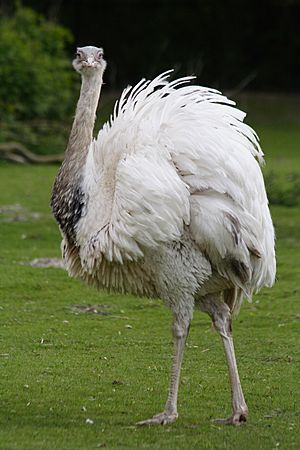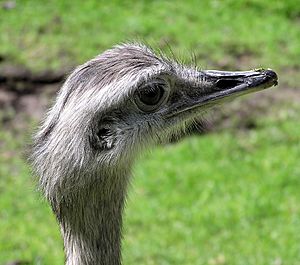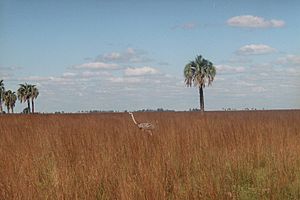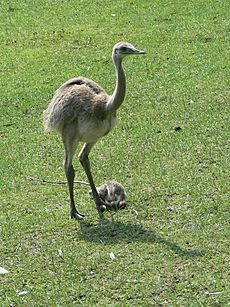Greater rhea facts for kids
Quick facts for kids Greater rhea |
|
|---|---|
 |
|
| Conservation status | |
| Scientific classification | |
| Kingdom: | |
| Class: | |
| Subclass: | |
| Infraclass: | |
| Order: |
Struthioniformes
|
| Family: |
Rheidae
|
| Genus: | |
| Binomial name | |
| Rhea americana (Linnaeus, 1758)
|
|
The greater rhea, Rhea americana, is a flightless bird found in South America. The greater rhea is also known as grey, common rhea, or the American rhea. The species, first described by Carl Linnaeus in 1758, is found in Argentina, Bolivia, Brazil, Paraguay, and Uruguay.
The greater rhea takes its scientific name from the Greek goddess Rhea and the Latin word for "America".
It has a length of 3–5 feet (0.91–1.52 m) and a wingspan of 5 feet (1.5 m). Weighing 50–55 pounds (23–25 kg), the greater rhea is the largest bird in South America.
Contents
Description


The adults have an average weight of 20–27 kg (44–60 lb) and measure 129 cm (51 in) long from beak to tail; they usually stand about 1.50 m (4.9 ft) tall. The males are generally bigger than the females. Large males can weigh up to 40 kilograms (88 lb), stand nearly 1.83 m (6.0 ft) tall and measure over 150 cm (59 in) long, although this is rare.
The legs are long and strong, and have three toes. The wings of the American rhea are rather long; the birds use them during running to maintain balance during tight turns.
Greater Rheas have a fluffy, tattered-looking plumage. The feathers are gray or brown, with high individual variation, In general, males are darker than females. Even in the wild—particularly in Argentina—leucistic individuals (with white body plumage and blue eyes) as well as albinos occur. Hatchling Greater Rheas are grey with dark lengthwise stripes.
Distribution, ecology and status
The Greater Rhea is endemic to Argentina, Bolivia, Brazil, Paraguay, and Uruguay. This species inhabits grassland dominated by satintail (Imperata) and bahiagrass (Paspalum) species, as well as savanna, scrub forest, chaparral, and even desert and palustrine lands, though it prefers areas with at least some tall vegetation. It is absent from the humid tropical forests of the Mata Atlântica and planalto uplands along the coast of Brazil and extends south to 40° latitude. During the breeding season (spring and summer), it stays near water.
A small population of the Greater Rhea has become established in Germany.
These rheas are legally protected in Germany in a similar way to native species.
Food and predators

The bulk of its food consists of broad-leaved dicot foliage and other plantstuffs, particularly seed and fruit when in season. Even tough and spiny vegetable matter like tubers or thistles is eaten with relish. Like many birds which feed on tough plant matter, the Greater Rhea swallows pebbles which help grind down the food for easy digestion. It is much attracted to sparkling objects and sometimes accidentally swallows metallic or glossy objects.
In fields and plantations of plants they do not like to eat, e.g., cereals or eucalyptus, the Greater Rhea can be a species quite beneficial to farmers. It will eat any large invertebrate it can catch; its food includes locusts and grasshoppers, true bugs, cockroaches, and other pest insects. Even small vertebrates like rodents, snakes, lizards, and small birds are eaten. Sometimes, Greater Rheas will gather at carrion to feed on flies; they are also known to eat dead or dying fish in the dry season, but as vertebrate prey in general not in large quantities.
The natural predators of adult Greater Rheas are limited to the Cougar and the Jaguar. Feral dogs are known to kill younger birds, and the Southern Caracara is suspected to prey on hatchlings. Armadillos sometimes feed on Greater Rhea eggs; nests have been found which had been undermined by a Six-banded Armadillo or a Big Hairy Armadillo and the rhea eggs were broken apart.
Reproduction

Greater Rheas breed in the warmer months, between August and January depending on the climate. The females move around during breeding season, mating with a male and depositing their eggs with the male before leaving him and mating with another male. Males on the other hand are sedentary, attending the nests and taking care of incubation and the hatchlings all on their own. The nests are thus collectively used by several females and can contain as many as 80 eggs laid by a dozen females; each individual female's clutch numbers some 5–10 eggs. However, the average clutch size is 26 with 7 different females eggs.
Rhea eggs measure about 130 mm × 90 mm (5.1 in × 3.5 in) and weigh 600 g (21 oz) on average; they are thus less than half the size of an ostrich egg. Their shell is greenish-yellow when fresh but soon fades to dull cream when exposed to light. The nest is a simple shallow and wide scrape in a hidden location; males will drag sticks, grass, and leaves in the area surrounding the nest so it resembles a firebreak as wide as their neck can reach.
The incubation period is 29–43 days. All the eggs hatch within 36 hours of each other even though the eggs in one nest were laid perhaps as much as two weeks apart. As it seems, when the first young are ready to hatch they start a call resembling a pop-bottle rocket, even while still inside the egg, thus the hatching time is coordinated. Greater Rheas are half-grown about three months after hatching, and sexually mature by their 14th month.
Conservation status
The Greater Rhea is considered a Near Threatened species according to the IUCN.
Rhea farming
This species is farmed in North America and Europe similar to the Emu and Ostrich. The main products are meat and eggs, but rhea oil is used for cosmetics and soaps and rhea leather is also traded in quantity. Male Greater Rheas are very territorial during the breeding season. The infant chicks have high mortality in typical confinement farming situations, but under optimum free-range conditions chicks will reach adult size by their fifth month.
Images for kids
-
Feral greater rhea in cereal field in Mecklenburg-Vorpommern, Germany. The species normally uses such monocultures to hide rather than to feed on the plants.
See also
 In Spanish: Rhea americana para niños
In Spanish: Rhea americana para niños






